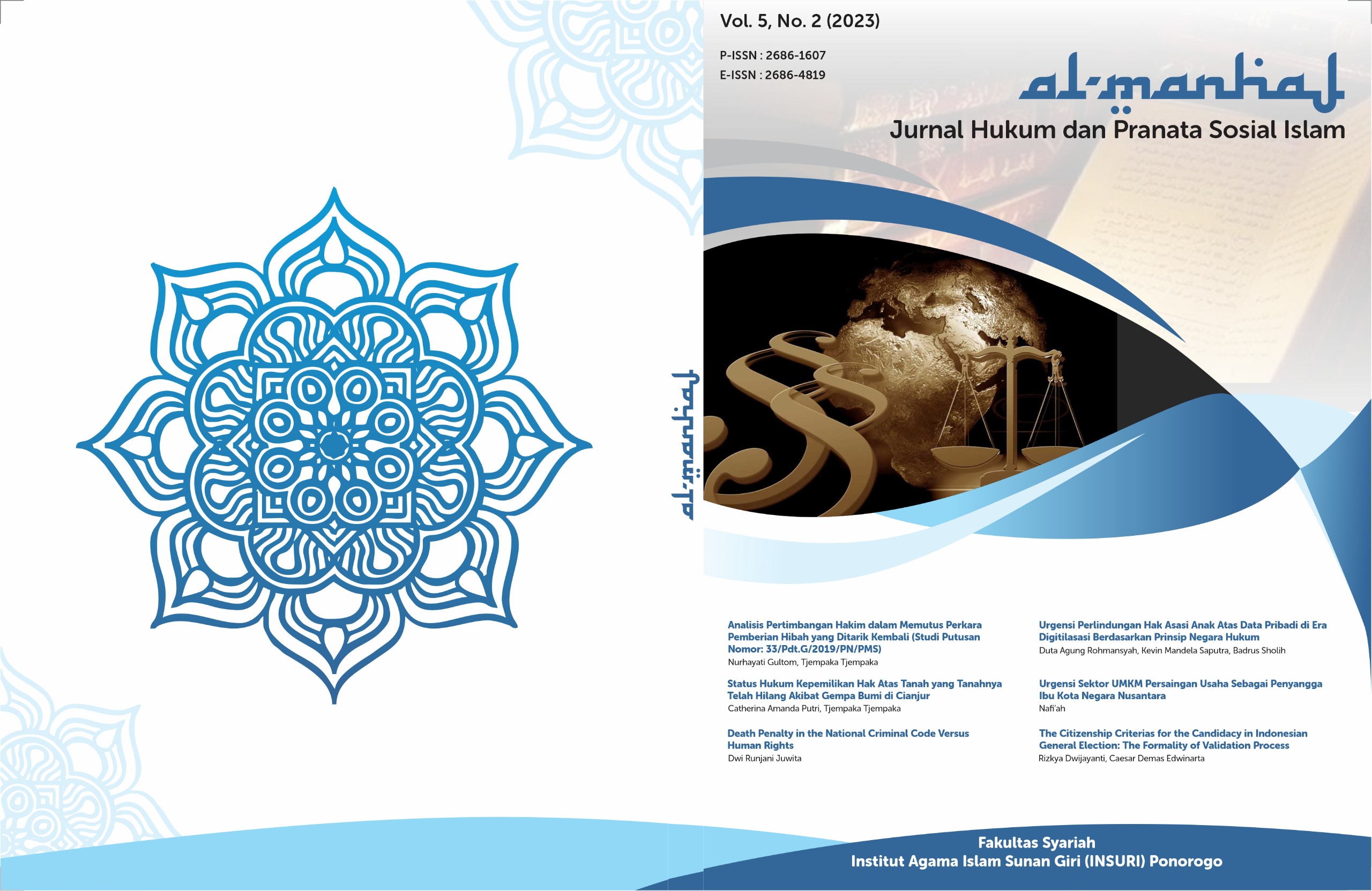Pengaruh Kemiskinan Struktural Terhadap Penegakan Hukum
DOI:
https://doi.org/10.37680/almanhaj.v5i2.3816Keywords:
Poverty; Structural; Law enforcementAbstract
The relationship between law and structural poverty requires critical thinking which is of course based on an icon that specifically examines the issue of the reciprocal relationship between law and society (people who are classified as poor), that structural poverty (for Indonesian society) seems to have a very strong influence on legal development (law enforcement) in Indonesia, research using normative juridical. The approaches used to conduct this research are: The statutory regulatory approach (the statute approach) and the legal concept analysis approach (analytical & conceptual approach). The influence of structural poverty on law enforcement in Indonesia can be manifested in poverty of knowledge and understanding of legal norms and/or rules so that it can directly or indirectly influence law enforcement in formal and material terms. Apart from that, their ignorance is also a factor that can influence universal law enforcement (which is based on legal development). As a suggestion in this paper, it is hoped that there will be a more constructive understanding of the relationship pattern between law and structural poverty so that looking at the influence of structural poverty on law enforcement does not lead to different perceptions and instead clouds our understanding of law and structural poverty.
References
Artidjo Alkostar, M. Sholeh Amin, L. B. H. (Yogyakarta). (1986). Pembangunan hukum dalam perspektif politik hukum nasional. In Rajawali. Rajawali.
Beridiansyah, B. (2019). Kajian Kriminologi dan Hukum Pidana terhadap Perilaku Vigilantisme pada Masyarakat. Wajah Hukum, 3(1), 89–96.
Fadila, P., Farisa, R., Maharani, R. N., Maharani, N., Nur, T., Siswanto, A., Dwiastuti, W., Nurrachman, A., Mulyadi, M., & Depok, K. (2023). Kemiskinan Struktural Akibat dari Tidak Berjalannya Fungsi Pemerintahan Secara Maksimal di Daerah Istimewa Yogyakarta. 1(3).
Lubis, T. M., & Lev, D. S. (1986). Bantuan hukum dan kemiskinan struktural. (No Title).
Muizunzila, F. A., Kaharuddin, K., & Maemunah, M. (2023). Fenomena Kemiskinan: Studi Pada Masyarakat Pemulung Di Panampu Kec. Tallo Kota Makassar. Jurnal Relasi Publik, 1(3), 26–34.
Ohoiwutun, M. G., Thesa, T. M., & Rahman, A. (2023). Metode Pembentukan Peraturan Tentang Penyelenggaraan Keolahraagan Di Kabupaten Merauke. Yustitiabelen, 9(2), 162–181.
Rahardjo, S. (2000). Ilmu hukum. Citra Aditya Bakti.
Rasjidi, L., & Sidharta, B. A. (1989). Filsafat hukum Mazhab dan refleksinya. Remaja Karya.
Seda, F., Dhakidae, D., Bertens, K., & Parera, F. M. (1992). Simfoni tanpa henti: ekonomi politik masyarakat baru Indonesia. (No Title).
Soekanto, S. (1976). Beberapa permasalahan hukum dalam kerangka pembangunan di Indonesia. Yayasan Penerbit Universitas Indonesia.
Soekanto, S., & Abdullah, Mustafa, H. (1987). Sosiologi hukum dalam masyarakat (Cet 3). Rajawali.
Wignjosoebroto, S. (2014). Dari hukum kolonial ke hukum nasional: dinamika sosial-politik dalam perkembangan hukum di Indonesia. (No Title).
Downloads
Published
How to Cite
Issue
Section
License
Copyright:
- Author retains the copyright and grants the journal the right of first publication of the work simultaneously licensed under a Creative Commons Attribution 4.0 International License that allows others to share the work with an acknowledgment of the work's authorship and initial publication in this journal.
- Author is able to enter into separate, additional contractual arrangements for the non-exclusive distribution of the journal's published version of the work (e.g., post it to an institutional repository or publish it in a book) with the acknowledgment of its initial publication in this journal.
- Author is permitted and encouraged to post his/her work online (e.g., in institutional repositories or on their website) prior to and during the submission process, as it can lead to productive exchanges, as well as earlier and greater citation of the published work (See The Effect of Open Access).
License:
-
Attribution — You must give appropriate credit, provide a link to the license, and indicate if changes were made. You may do so in any reasonable manner, but not in any way that suggests the licensor endorses you or your use.
-
No additional restrictions — You may not apply legal terms or technological measures that legally restrict others from doing anything the license permits.
You are free to:
- Share — copy and redistribute the material in any medium or format
- Adapt — remix, transform, and build upon the material for any purpose, even commercially.

This work is licensed under a Creative Commons Attribution 4.0 International License.














